
Migrating and open-sourcing my blog
Today I talk to you about the recent changes I made to my blog when I migrated it to Statiq and open-sourced it.
Some context
I initially created my blog in March 2019 using:
- Wyam (a .NET static website generator) to generate the website
- Azure Repos to store the source code on a private git repository
- Azure Pipelines to build and deploy the website
- Netlify to host the website
- Disqus to allow visitors to comment on my articles
A little bit more than 2 years later in October 2021, everything was still working perfectly fine and I could have let everything that way. Yet, I thought some things could be improved and I wanted to change some parts of this stack.
Migrating from Wyam to Statiq
Why?
I am convinced that static website generators have a great future and are one of the best solutions for blogs #ThisIsTheWay.
Although Wyam was working fine for my blog, it has been "rebranded and rebooted as Statiq with a ton of improvements" (as you can read on Wyam website) so it made sense to migrate to use an actively maintained tool.
I could have migrated to another static website generator (there are so many of them!) but I like using one written in .NET. If I want to customize how my website is generated, I can easily modify the code as it's .NET code. So Statiq is a good choice for me.
Statiq I am talking about the static site generator but technically Statiq is more than that. It is a static generation platform that is divided into 3 parts:Statiq Framework➡ a framework to build a custom static generator applicationStatiq Web➡ a static website generation toolkit built on top ofStatiq FrameworkStatiq Docs➡ a toolkit built on top ofStatiq Webto generate a site with .NET API documentation You may not know, but the .NET Foundation website is generated usingStatiq.Web.
How?
Migration was quite easy (some CSS classes to replace and some configuration to change and that was it!). Statiq has a page in its documentation to explain how to do that.
The main difference is that instead of using the Wyam CLI to generate my blog from my articles in markdown and a config file, I now have a .NET console application that I run to do the same.
What changed?
Although Statiq is a reboot of Wyam, and a lot has changed internally, my blog is pretty much the same as before. Statiq comes with the theme CleanBlog that I was using before with Wyam so the UI looks the same. However as it uses a more recent version of the theme, the migration brought a few improvements to my blog:
- there is now a search box to search my blog (everything is indexed so finding an article that might interest you is easier than ever)
- the code highlighting is prettier than before
You can see below an example of that:
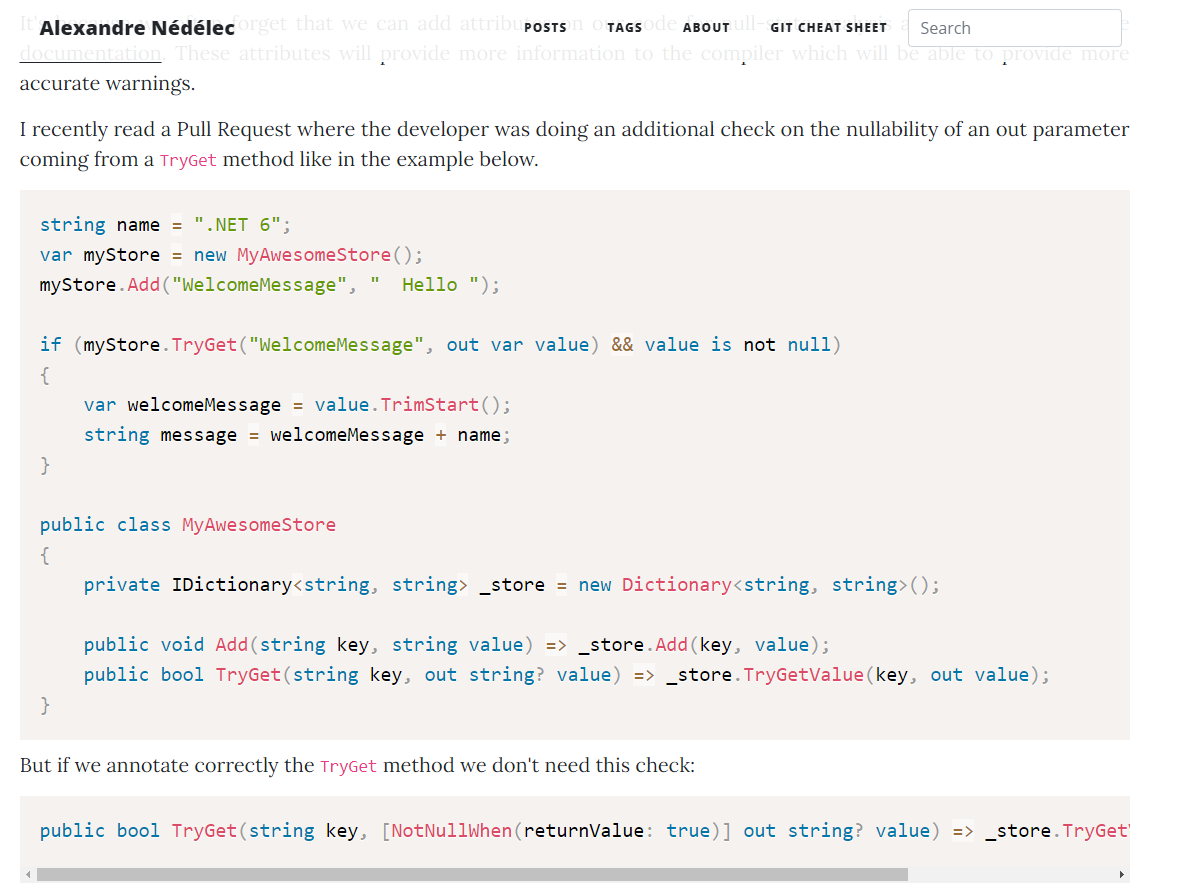
I also took the opportunity of migrating my blog to correct a lot of grammar and spelling mistakes there were on my articles. To find the mistakes and correct them I used the free version of Grammarly and I was surprised by how good it was. I intend to use it to write my future articles and I strongly recommend it to you. It is especially useful to me as I am not an English native speaker. Of course, I am not saying there will be no mistake in my articles but I should catch most of them with Grammarly.
Open-sourcing my blog
People interested in creating their blog sometimes ask me what stack I used to build my blog. So I thought open-sourcing my blog would be a great way to answer this question and show exactly how this blog is built. If you are a .NET developer and want to create your blog, I strongly recommend you to use Statiq Web. You can get started by following the documentation, it is very easy. And now, you have an example of a blog using Statiq that you can look at here.
I am often a consumer of open source code (as we all are these days) so it feels great to be a contributor this time by sharing the source code of my blog (even if there is currently not much customization). I don't expect many people to look at it but at least it's there if you care.
All-in on GitHub
GitHub is one of the best platforms for open source projects. But whether it be for open source or proprietary software, GitHub is above all a great development platform to build, ship, and maintain software. I am more familiar with Azure DevOps which is a great platform too and that I use at work but using GitHub was the opportunity to learn new things. Therefore, I decided to migrate to GitHub for my blog and not only for hosting the code.
Hosting the source code of my blog
Speaking of hosting the code, here is my new git repository on GitHub:
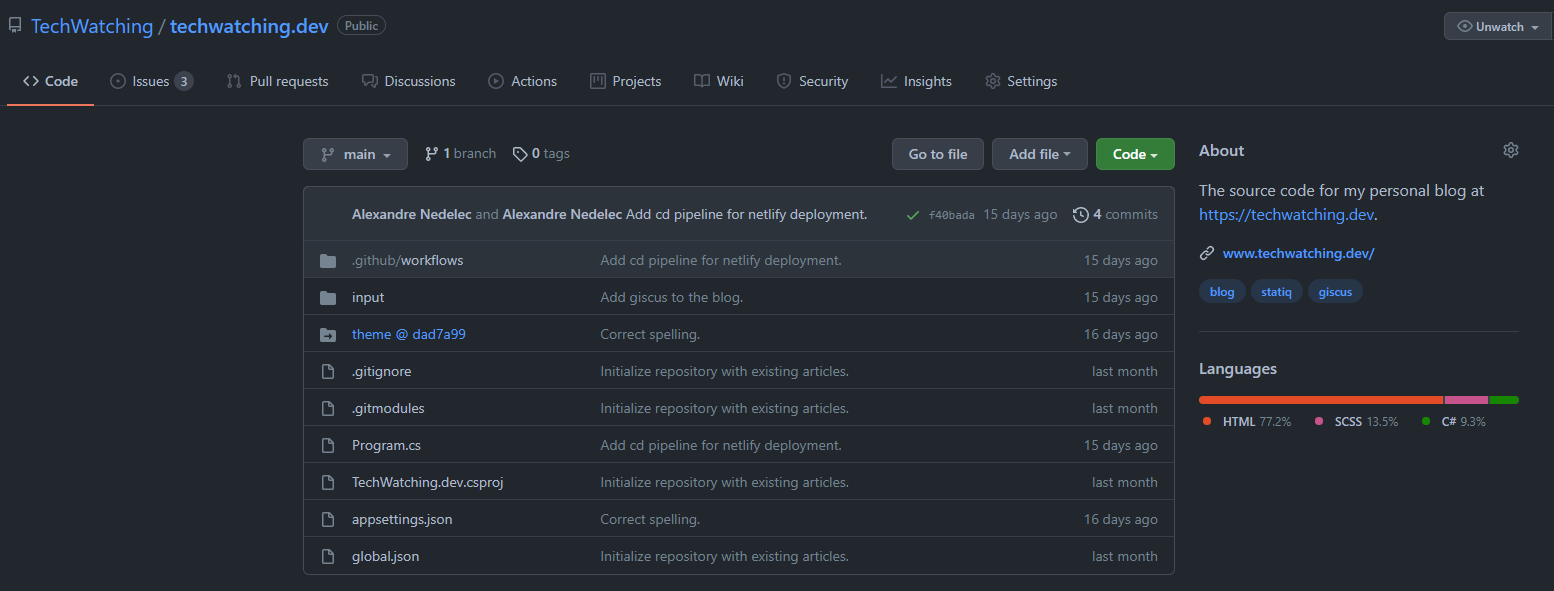
To move my code to GitHub, I just created a new git repository in GitHub and copy-pasted my code there. Adding GitHub as a new remote of my repository could have been a better way to migrate my code to GitHub while preserving the commit history. However, I did not care about history and took the opportunity to reorganize my code.
And now that my git repository is on GitHub, I can use the github.dev web-based editor to modify my repository directly in the browser. How cool is that?
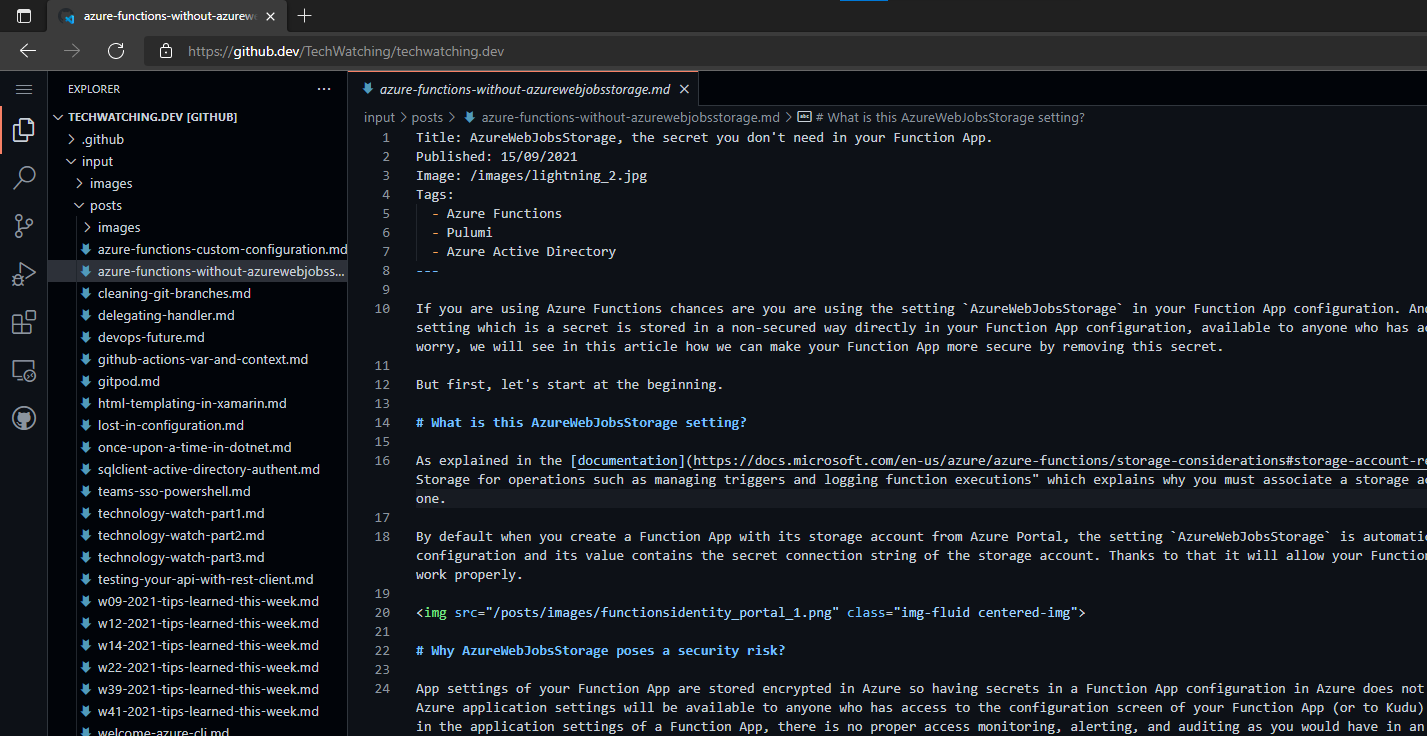
I don't know if I will use github.dev a lot but I like the fact of being able to work on my blog from any computer without having to install anything.
. to open this repository in a vscode-like editor that runs entirely in your browser. You can also replace github.com with github.dev in the URL to open it. It even works on your mobile although I don't find it very convenient.Building and deploying my blog
Coming from Azure DevOps, moving from Azure Pipelines to GitHub Actions was not a big deal. What changed however is that my pipeline doesn't need to install any specific CLI to build and deploy my blog. Indeed, with Statiq my blog is a .NET console application, so my site can be generated directly with the .NET CLI. Statiq as built-in support for deploying a website on different platforms including Netlify thus my pipeline to generate and deploy my site is quite simple:
name: Deploy Blog to Netlify
on:
push:
branches:
- main
schedule:
- cron: "0 5 * * *"
jobs:
build:
runs-on: windows-latest
steps:
- uses: actions/checkout@v2
with:
ref: main
submodules: recursive
- uses: actions/setup-dotnet@v1
with:
dotnet-version: '5.0.x'
- run: dotnet run -c Release -- deploy
env:
NetlifySiteId: ${{ secrets.NetlifySiteId }}
NetlifyAccessToken: ${{ secrets.NetlifyAccessToken }}
This pipeline runs every day and each time something is merged on my main branch. This way my website is redeployed when I publish a new article (which generally corresponds to a commit being made on the main branch through the merge of the branch where I was writing the article). This also allows me to finalize an article but publish it at a future date without having to take care of it.
Hosting my website
This is the only part where I did not really go all-in on GitHub as I did not use GitHub Pages to host my blog, I kept Netlify. I am happy with it, it does the job, costs me nothing, and allows me to have previews of my blog if I want to so there was no reason to change.
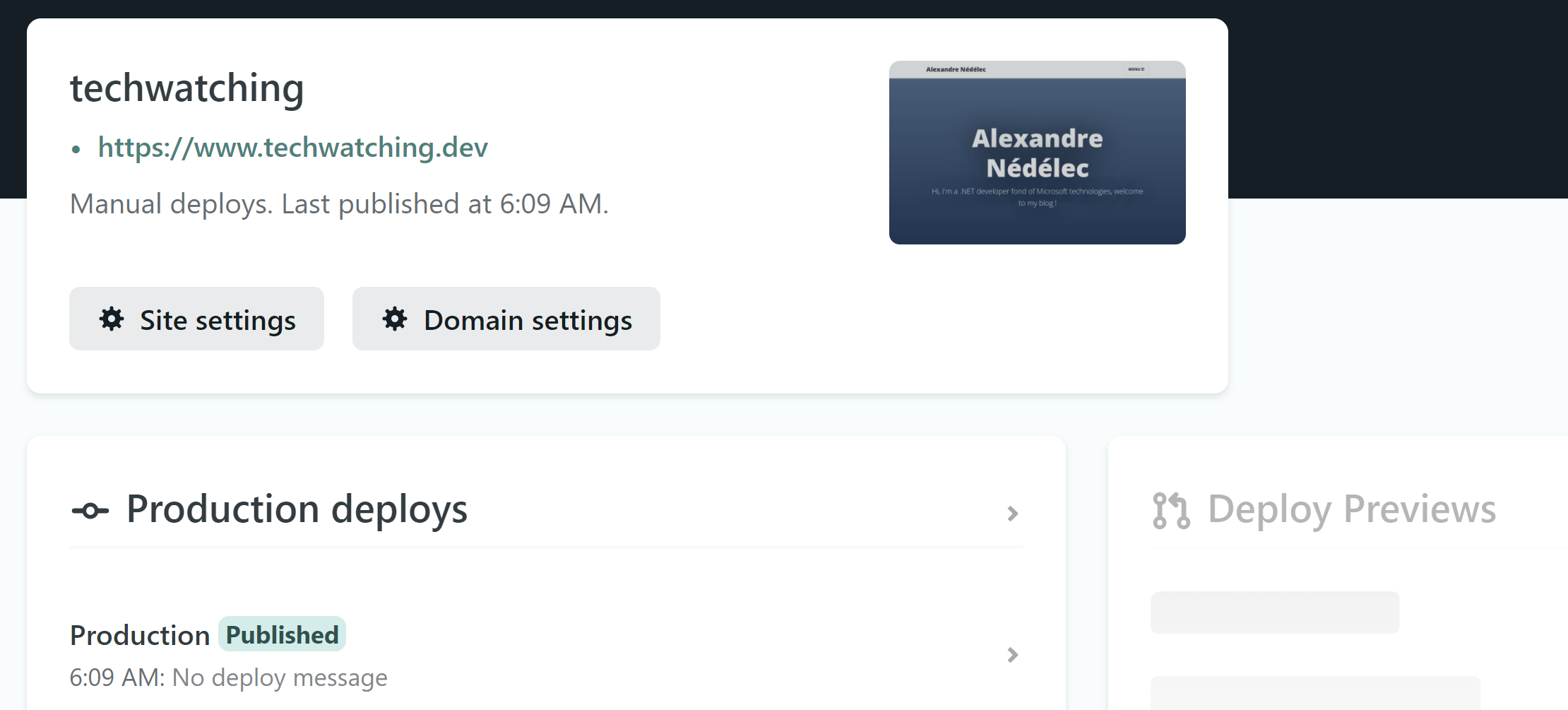
Providing a comments system
I was previously using the well-known comments system Disqus to let readers of my blog comment on the articles. To be honest, it works well, has a lot of features (moderation, monitoring...), and is used on many blogs. However, I have always found it a bit complex for my needs and was annoyed to "force" my readers to create a Disqus account to write comments. So when I read articles of people complaining about Disqus ads, tracking and performance issues I knew it was time to find an alternative.
And there are many alternatives to Disqus! But one I found very interesting was utterances, a GitHub application that relies on GitHub issues to store blog comments. As the creator of this library explains here, utterances served as a POC for the GitHub-based feedback system in Microsoft Docs. I thought using GitHub issues for the comments of my blog was awesome because:
- my readers will not have to create an account to write comments, my readers are developers so they probably already have a GitHub account
- with comments stored as GitHub issues on my GitHub repository, I have everything at the same place (code, pipelines, and comments)
But you know what? I finally did not choose utterances as the comments system for my blog 😀. Instead, I chose to use giscus which is similar to utterances (in fact it is heavily based on it) but stores comments in GitHub Discussions. GitHub Discussions did not exist when utterances was created but I think discussions are a much more appropriate place than GitHub issues to store comments, that's why I chose it. Apart from that, advantages are the same as utterances.
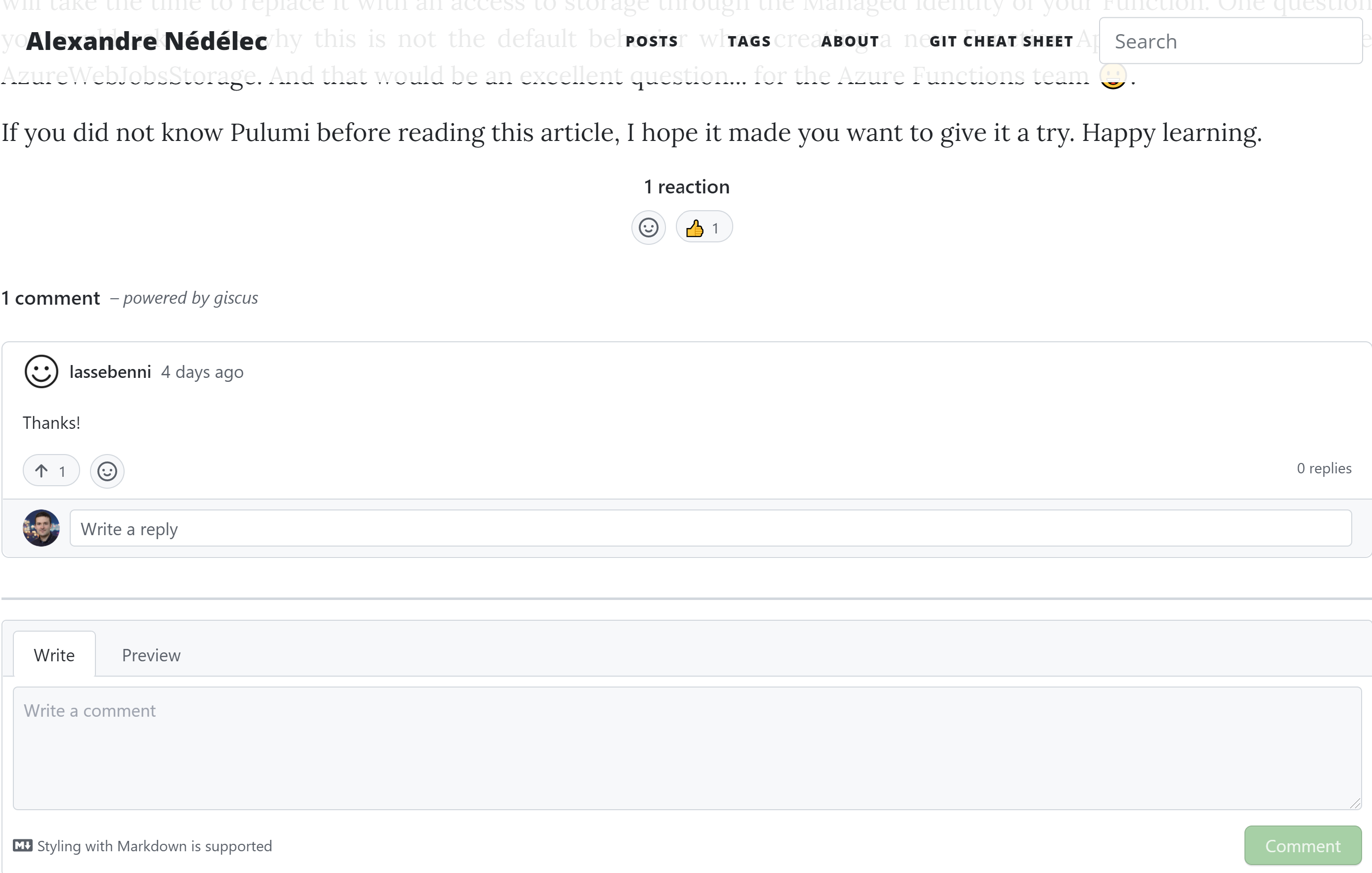
If you don't have a comments system on your blog yet or that your current one does not satisfy you, you should check giscus, I am very happy with it.
giscus (while preserving your existing comments), the easiest way I found was to export the Disqus comments in a file, use this tool on GitHub to convert them into issues, and manually convert existing issues to discussions on each issue page. You can read this blog post that partially explains how to do that.Managing my blog as a project
My blog is not very hard to manage but there are always things to do or think about: improvements to do, articles to write, ideas to find. Instead of writing that down on my ToDo app or my OneNote as I used to do, I decided to use the GitHub Issues beta that allows you to create a "project" with a backlog, boards, and issues that can be categorized with custom fields.
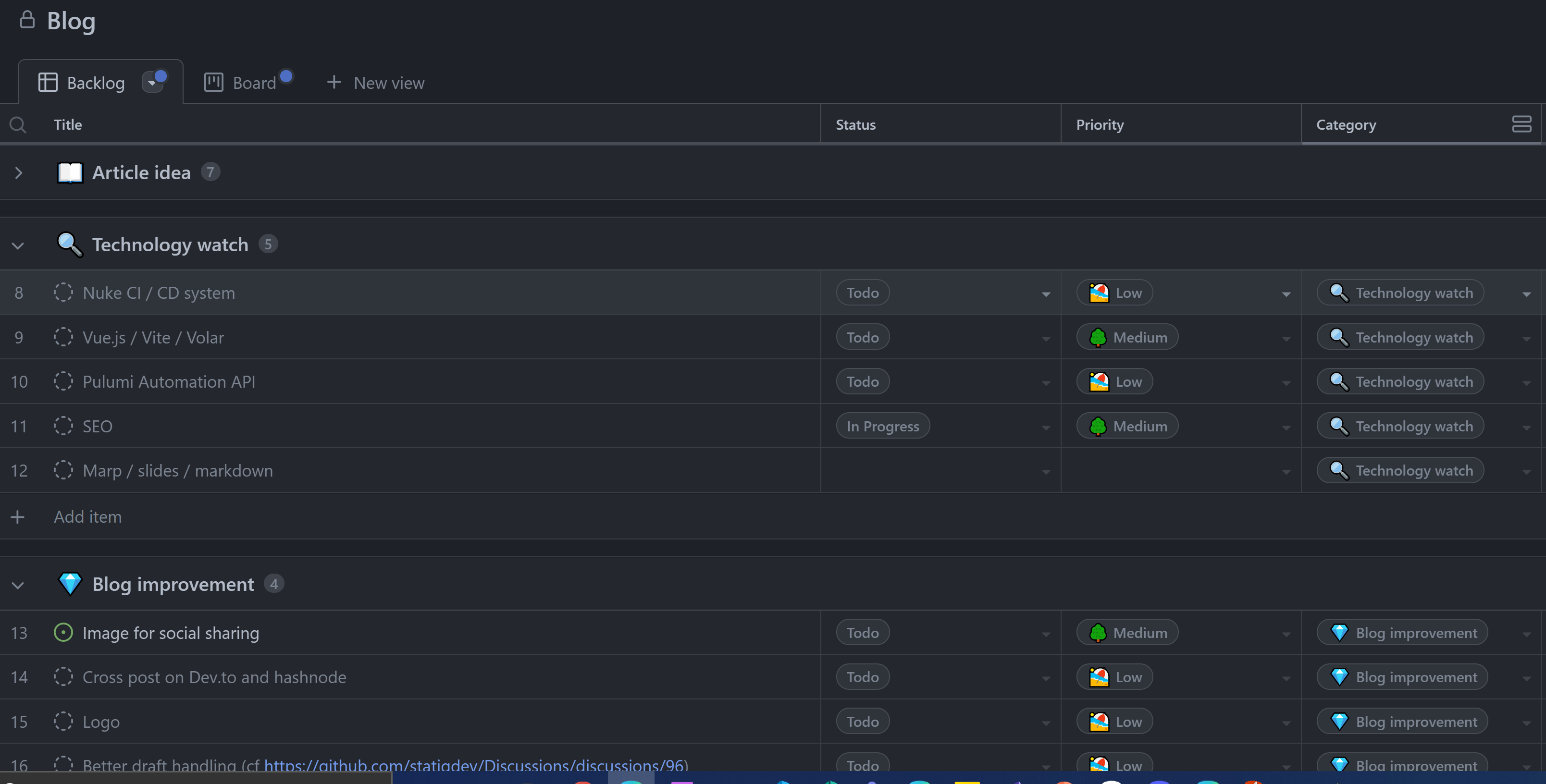
Summary
In this article, I talked to you about what changed on my blog, and what my new stack is:
- Statiq a .NET static website generator to generate the website
- GitHub to store the source code on a public (open source) git repository
- GitHub Actions to build and deploy the website
- GitHub Issues (beta) to manage my ideas for the blog
- GitHub Discussions with giscus to allow visitors to comment my articles
- Netlify to host the website
I like this new stack where most things are centralized in one place: GitHub. I own the content of this blog, but I love that code to generate this blog is open source. There is still plenty of room for improvement on my blog, but I am confident Statiq will help me to continue customizing my blog easily. I hope you liked this article, do not hesitate to comment (you now know how comments work behind the scenes 😀).